How do you breathe new life into 13,000-year-old fossilized bones? How do you retell stories almost as old as time itself?
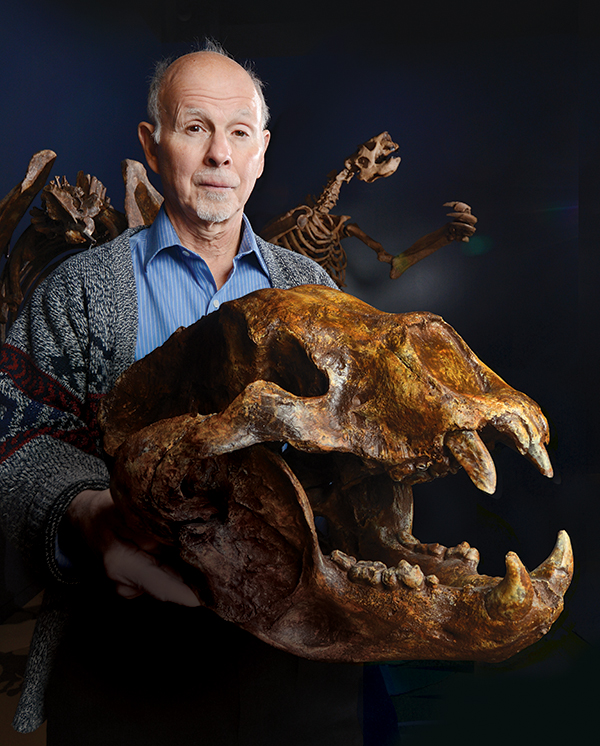
Ron Richards, a senior research curator at the Indiana State Museum and Historic Sites, holds a cast of the skull of a short-faced bear. Behind him stands a cast of the skeleton of a ground sloth, a 9-foot-long, bison-sized beast that is a distant relative of the modern tree sloth. Both giants roamed Indiana during the Ice Age some 13,000 years ago.
Photo by Richard G. Biever
Visitors to the Indiana State Museum in Indianapolis will have a chance to find out later this month — just in time for spring break trips to the state capital.
The state museum will unveil the second of its multi-phase redesign of core exhibits March 24. And unlike when it moved into its state-of-the-art new digs on the west side of downtown Indianapolis in 2002, museum curators say this time they are going to let the found remains of Indiana’s earliest critters — the mastodons and woolly mammoths, saber-toothed cats, dire wolves and giant ground sloths — tell more of the story directly to visitors.
“Between then and now, visitor expectations of a museum visit have significantly changed,” said Brian Mancuso, the museum’s vice president of experience. “They want it to be more experiential, more immersive, more interactive than museums of the past. Interactive museums create memorable touch points.”
For instance, Mancuso noted when visitors read about the massive glaciers of the last Ice Age “scouring Indiana flat,” they’ll have the opportunity to drag a piece of granite across limestone in the same way a glacier would have moved over the land.
“For those people that want to experience the business end of a saber-toothed cat tooth, you can feel that,” he said. “It’s this tactile experience you’re getting. More than just reading, more than just looking, you’re able to actually feel the thing.”
Everyone learns and remembers things in different ways, he noted. By providing text, audio and tactile experiences, the museum’s “universal design” tells the story of Indiana’s past more fully for everyone, especially those who may be visually impaired.
“When we opened [in 2002], we were on the cusp of everyone trying to use computer screens to interpret,” said Peggy Fisherkeller, curator of geology at the museum. “That’s been a big change because [museums] are using computer screens a lot less now. We’re trying to present experiences that people can’t have sitting in their house. In the early 2000s, it was all really new.”
“Everybody’s got a computer in their pocket, now,” added Damon Lowe, senior curator of science and technology.
In many ways, the 2002 museum exhibits offered too much detail, museum curators talking about the changes agreed, and it was all presented in a similar fashion. “Everything had the same weight,” noted Lowe.
“It was a lot,” added Fisherkeller. “Our thinking was we’ll put the words there, and if people don’t read it all, it’s fine.”
But over the years, beyond simply observing what information visitors were taking in or passing by, curators learned from visitor surveys something a tad unsettling about all those words. Though few visitors would have time to read every screen and placard, some expressed guilt about skipping things — akin to the guilt some folks may have about skipping a workout or playing hooky. “People had this internal bad feeling that we didn’t intend them to feel,” Fisherkeller said.
Lowe said the new design will accentuate the most significant points of what visitors want to know — not what the curators think they need to know.
“We’re not really the best judge of what they need to know,” he said. “But if we ask them what they want to know, then we can give it to them.”
“The gallery was 15 years old,” added Fisherkeller, “so I think it was time to present new information in a new way.”
One new feature will be a sub-glacial tunnel that will take visitors passing through to an otherworldly place and another time. Recordings of water running off and the creaking and cracking from inside an actual modern glacier will be heard. A cool wind will also hit visitors at the entrance to the tunnel — just as wind would blow from off the top of a real glacier.
“I wanted people to have a sense of how this feels,” Fisherkeller said. “Indiana was covered by an ice sheet up to about 16,000 years ago. So this is an imagining of what that climate might have been like.”
During the last Ice Age, the northern two-thirds of Indiana was covered by an immense glacier, a moving sheet of ice a half mile to a mile thick. This is why most of Indiana is flat. The land was scoured by the slow moving mountain of ice and rocks, and then filled and leveled by glacial till. But the spine of uplands from around Bloomington south to the Ohio River that the glaciers missed were also shaped by the glaciers. As they melted, the run off carved and molded the hills and hollows.
“Hopefully, visitors get a sense that the ice was here. It was big. It modified the land. It changed our life,” added Ron Richards, senior research curator of paleobiology at the museum.
In addition to the ice being big, Richards talks about the wildlife that once teemed throughout the region. “I am still awed at the immense size of some of these animals and at how abundant their remains are in Indiana. But many more lie buried …. Folklore relates that any bog larger than an acre likely has mastodon remains in it.”
That segues to another focus of the new exhibitions: the Indiana State Museum’s focus on discovery. The museum is responsible for unearthing more ancient mammals than any other Indiana institution. The new exhibits will explore the museum’s efforts to find and preserve Indiana’s last native giants.
“The exhibit feeds into the active field work going on that a lot of people in the public probably don’t necessarily know about. But it is something that is pretty unique about this museum,” said Hannah Kiefer, the state museum’s director of communications. “We have active digs going on. You can see the product of that.”
Another exhibit in the new “Frozen Reign” gallery depicts a cave setting featuring bones and scenes created from actual underground excavations in southern Indiana.
“This is not just a fabrication of the cave. This is an actual mold and cast of the cave. We went underground. This is an exact duplicate of what the underground was like 25,000 years ago,” said Richards.
By the completion of this multi-phase project, museum visitors will get to travel through space and time — from the distant past to the possible future and back, examining artifacts in a way that’s more interactive, more immersive and more hands-on.
“It is a rethinking of how it’s shown, what’s shown, how the visitor moves through the space, and how they’re experiencing the space,” said Mancuso. “It’s as new as new can be ….”
And telling a story as old as fossilized bones in a way that’s “as new as new can be” is truly saying — and showing and touching on — something, indeed.
RICHARD G. BIEVER is senior editor of Electric Consumer.
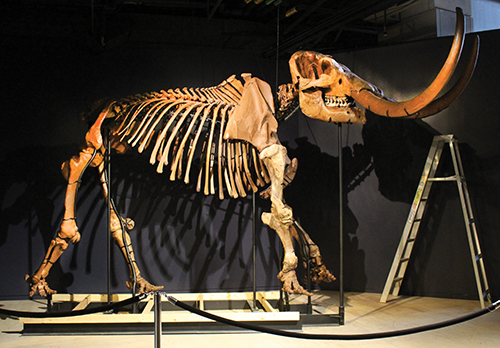
Renovations to the state museum allow it to unpack ancient pachyderm “Fred,” the museum’s mastodon, and fully display his fossil bones (shown here shortly after he was assembled in January in preparation for the gallery’s opening later this month). Fred was discovered in 1998 by Dan Buesching while looking for peat on his family’s farm near Fort Wayne. Fred Buesching, Dan’s grandfather and Fred’s namesake, discovered peat on the farm in 1947 which was the start of the family’s peat moss and mulch business that continues today. Though Fred’s been displayed before, this is his first permanent home since he was excavated from the peat bog where he’d spent the previous 13,000 years.
Photo by the Indiana State Museum
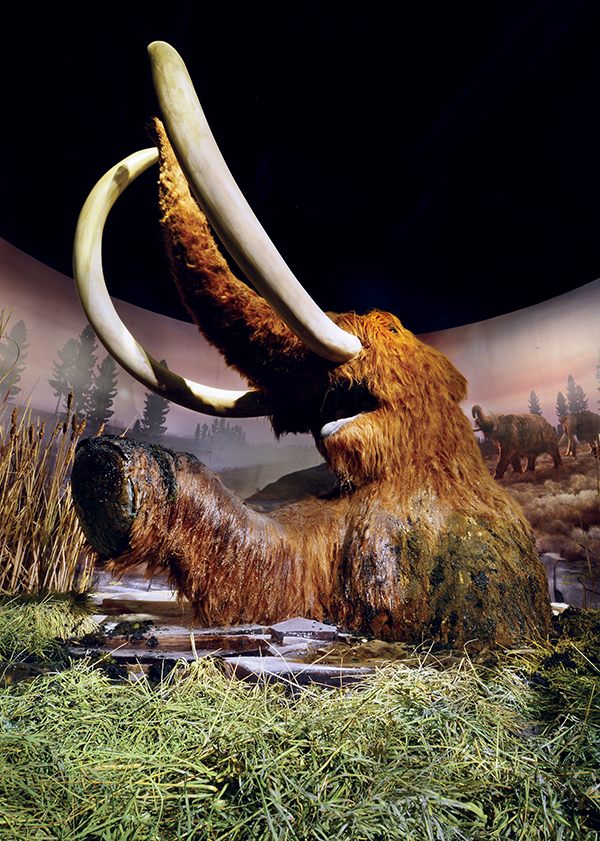
How Fred the mastodon (on the opposite page) met his demise near present-day Fort Wayne during the last Ice Age some 13,000 years ago is not certain. But many mastodons have been found in what were once ancient bogs around Indiana. Part of the redesigned “Frozen Reign” gallery depicts the giant frame of a mastodon cracking through the ice on a bog and, despite trumpeting and thrashing about, it would have languished until it drowned, starved or was attacked by more mobile meat eaters, like bears or wolves.
Photo by Richard G. Biever
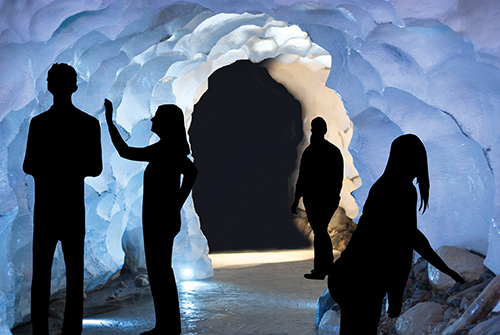
The new “Frozen Reign” gallery takes visitors through a sub-glacial ice tunnel with cool breezes and sounds of dripping and cracking from an actual glacier. During the last Ice Age, sheets of ice a half mile to a mile thick covered the upper two-thirds of Indiana.
Photo by the Indiana State Museum
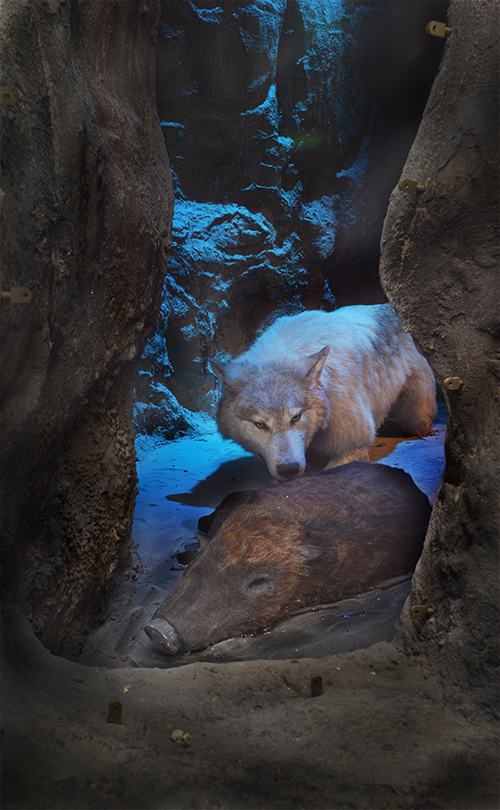
A dire wolf attacks a peccary in a pit where both will eventually perish in a recreation of animal life in the Indiana Ice Age some 13,000 years ago. An excavation by the state museum of the death pit in a cave in Southern Indiana found the bones of both animals among others. The exhibit’s pit walls are cast from the actual walls of the excavation site. Photo by Richard G. Biever
About the Phase 2 redesign project
Phase 2 of the museum’s core gallery redesign opens March 24. The new core galleries are:
• Frozen Reign: A State of Change — feel the tooth of a saber-toothed cat, explore an ice tunnel, hear how mastodons communicated, and see bones from many now-extinct animals that roamed Indiana; covers the time frame from 5 million years ago up to 11,700 years ago.
• First Nations: The Story of Indiana’s Founding People — learn about the culture and communities of Indiana’s founding people through their games, tools and traditions. The exhibit also shares how descendants of those nations continue to thrive in the modern day; covers the time period from 11,700 years ago up to 318 years ago.
• The R.B. Annis Naturalist’s Lab — explore Indiana’s natural history in this place for hands-on exploration.
Fred, the Indiana State Museum and Historic Sites’ iconic mastodon skeleton, will now greet visitors from a new permanent post at the gallery entrance. Follow Fred on Twitter: @FredIndiana.
- To learn more about the Indiana State Museum and Historic Sites, visit its website: indianamuseum.org
- To learn more about the Buesching mastodon find, visit: https://www.bueschings.com/about1
Indiana State Museum facts, figures & FYIs
Experience the Hoosier story at this world-class institution and its 11 state historic sites that feature unique, hands-on exhibits and artifacts which individually and collectively showcase the events and characters shaping Indiana’s history.
The museum opened its present facility in White River State Park in downtown Indianapolis in the spring of 2002. A multi-phase redesign to its core, permanent galleries began in 2016 to make each gallery more immersive and interactive.
The museum celebrates its sesquicentennial in 2019.
Near the museum are other points of interest: the Statehouse; Eiteljorg Museum of American Indians and Western Art; NCAA Hall of Champions; Indianapolis Zoo; Eugene and Marilyn Glick Indiana History Center; Victory Field, home of the Indianapolis Indians minor league baseball team; and Lucas Oil Stadium, home of the NFL Indianapolis Colts.
About the redesign
• Phase I galleries – “Contested Territory,” “Natural Regions” and “19th State” – opened Nov. 12, 2016.
• Phase 2 galleries open March 24.
• The remaining galleries will close and reopen in subsequent phases.
Museum and Historic sites at a Glance
• Founded in 1869
• All 92 Indiana counties represented in sculptures on museum exterior
• 90 buildings over 1,400+ acres
• Five National Historic Landmarks and one National Engineering Landmark
• One of the three largest Abraham Lincoln collections in the world, due mostly to ISM receiving the collection of the former Lincoln Museum in Fort Wayne from the Lincoln Financial Foundation in December 2008.
Museum Nuts & bolts
• Address: 650 W. Washington St., Indianapolis, 46204
• Hours: Mon-Sat — 10 a.m.-5 p.m.; Sun — 11 a.m.-5 p.m.
• General Admission:
Adult — $14.95; Child — $9.95
Call the museum at 317-232-1637 or visit indianamuseum.org for discounted admission and group packages, special closings, extended hours, IMAX information and other details.




